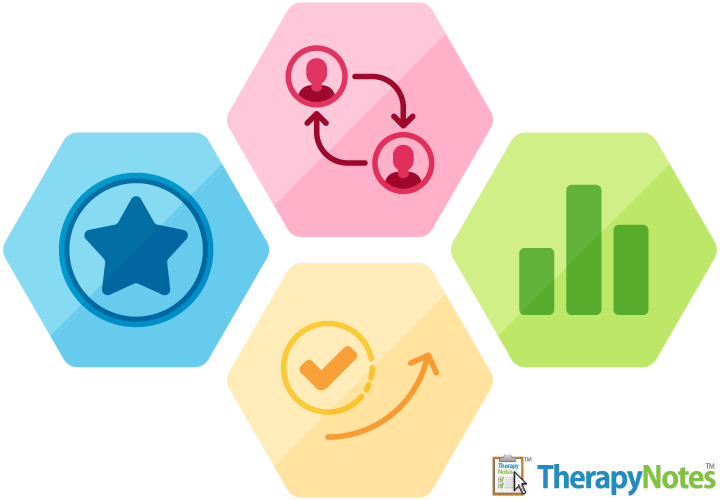What is MIPS?
By TherapyNotes, LLC on January 17, 2020

As part of the Quality Payment Program mandated by the Medicare Access and CHIP Reauthorization Act of 2015 (MACRA), Medicare established the Merit-based Incentive Payment System (MIPS) to encourage clinicians to engage in specific practices with the ultimate goal of improving the quality of patient care. MIPS replaces several other programs that you may be familiar with, such as PQRS and Meaningful Use.
MIPS consists of four components:
- Quality: Quality measures are the replacement for the Physician Quality Reporting System (PQRS) and are similar in many ways. Quality measures report on the quality of care that you provide for your clients. Generally, a practice will choose 6 different Quality measures to report on. Commonly chosen Quality measures for TherapyNotes™ users include some about documenting medications in the client chart, administering depression screeners (such as the PHQ-9) and documenting a follow up plan, and screening for tobacco or unhealthy alcohol use.
- Improvement Activities: A new category under MIPS, Improvement Activities are processes and approaches meant to improve and enhance access to care. Categories for Improvement Activities include options like Integrated Behavioral and Mental Health, Achieving Health Equity, and Expanded Practice Access. Activities are weighted based on their alignment with public health goals, and a practice must report on a combination of activities to reach a minimum threshold.
- Promoting Interoperability: Recently renamed, this category replaces the Meaningful Use program. Meant to spur the adoption of certified electronic health record technology (CEHRT) and the exchange of health information between providers, Promoting Interoperability activities are not required for mental or behavioral health providers.
- Cost: Replacing the Value Based Modifier, the Cost category requires no additional effort on your part. Medicare will automatically calculate the cost of care based on claims you submit.
For each of these activities, you may be required to implement a new process and document outcomes for 90 days or make sure the activity is documented at least once per year in the client record. The performance year (when you need to do the activities) lasts January 1 through December 31. You have an additional 3 months, until March 31, to report to Medicare what you did.
Does Participating in MIPS Matter?
Medicare issues “payment adjustments” based on your level of participation in MIPS. After all scoring is reported by March 31, Medicare will take several months to make calculations and send a report to all MIPS-eligible providers (usually around September). This report will show your level of participation and the impact it will have on your payments from Medicare. This impact will be applied to all payments the following year. For example, if you engaged in MIPS activities in 2019 and reported by March 31, 2020, your payments for all of 2021 will be impacted. The amount of the impact changes each year; payment adjustments for 2020 (based on activities from 2018) will range between -5% and +5%, while payment adjustments for 2021 (based on activities from 2019) will range between -9% and +9%. Completely ignoring MIPS will result in a full negative payment adjustment, meaning Medicare will withhold 9% of your revenue in 2021. Minimal participation will result in no adjustment being applied; Medicare won’t withhold any payment, but you are also not eligible for any bonus payments. Full participation could result in additional 9% in bonus payments for 2021. Since Medicare rates are publicly available, let’s estimate the impact of MIPS participation on reimbursement rates.
Although pricing varies by region, both 90791 and 90837 average about $140. This means participation can impact your per-session rate by about $12.60, or a $25 swing between no participation and full participation. For each client, that can have a significant impact:
| Number of Sessions | No Participation (-9%) | Minimal (0%) | Full Participation (+9%) | Difference (None vs Full) |
| 5 | $637 | $700 | $763 | $126 |
| 10 | $1274 | $1400 | $1526 | $252 |
| 15 | $1911 | $2100 | $2289 | $378 |
| 20 | $2548 | $2800 | $3052 | $504 |
How Do I Participate?
First, you can quickly check your individual participation status by using the CMS look up tool. If you would like to see if your practice as a whole is required to participate, you will need to sign in (or sign up for an account). There are several criteria you must meet if you are mandated to participate. If you meet at least one, but not all, of the criteria, you can also opt-in to participation. You can also work with other providers to create a Virtual Group (where several different entities with different TINs join together).
Next, decide how you want to report data. Unlike the old PQRS system, MIPS data generally cannot be reported by including additional service codes on claims. The most efficient method of data reporting is to use a registry. TherapyNotes™ has partnered with Healthmonix to offer two different registry reporting options:
- The Mental and Behavioral Health Registry (MBHR) is the result of a special partnership between the American Psychological Association and Healthmonix. Geared specifically toward mental and behavioral health providers, the MBHR includes approximately 25 MIPS identified Quality measures and 12 specialty measures, exclusive to the MBHR, that can be submitted directly to the Centers for Medicare and Medicaid Services. It is the only registry that includes measures to screen for anxiety disorders and report anxiety disorder treatment response. It also includes measures related to impaired functioning, such as sleep quality, pain interference, social role functioning as well as two neuropsychology process measures. Access to these specialty measures gives you greater flexibility in reporting patient-reported outcome measures that fit seamlessly into your practice to get full participation points.
- The MIPSPRO platform offers the full complement of MIPS identified Quality measures to fit the needs of a broad range of providers, without the inclusion of specialty Quality measures.
Submitting data to the registry of your choice is simple with TherapyNotes™—just write your notes! Very similar to billing with TherapyNotes™, every time you sign a note information is captured. If the session is going to be billed to Medicare, TherapyNotes™ not only prepares a claim for you to submit but also sends the data to the registry. Once in a while, simply log in to your registry account to confirm which activities apply to each session. Healthmonix helps make it easy to review your data on a real-time basis, allowing you to guide your practice activities. You’ll also see which measures you’re likely to get the most points for, ensuring maximum reward for your participation. Review your information between January 1 and March 31, then easily submit your data to Medicare with just a click.
* The content of this post is intended to serve as general advice and information. It is not to be taken as legal advice and may not account for all rules and regulations in every jurisdiction. For legal advice, please contact an attorney.
Get more content like this, delivered right to your inbox. Subscribe to our newsletter.
More Content You'll Enjoy

Medicare Telehealth Update: New In-Person Visit Rules Effective January 2026

Understanding Medicare's Inclusion of MFTs and MHCs: An Informative Guide for Therapists
